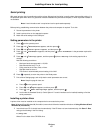
Verifying the IP settings
18
Installing drivers for network printing
9 Using the numeric pad, enter the IP address. Once the address is entered, press .
Submitting Selection appears briefly.
10 Press repeatedly until the printer returns to Ready.
Verifying the IP settings
1 Print another network setup page. Look under the “TCP/IP” heading, and make sure the IP address, netmask, and
gateway are correct. See Printing a network setup page on page 17 if help is needed.
2 Ping the printer, and verify that it responds. At a command prompt on a network computer, type ping followed by
the new printer IP address (for example, 192.168.0.11).
Note: On Windows computers, click Start
Æ Programs Æ Command prompt (or Accessories Æ
Command prompt if using Windows 2000).
If the printer is active on the network, a reply is sent.
After the TCP/IP settings are assigned and verified, install the printer on each network computer.
Windows
In Windows environments, network printers can be configured for direct printing or shared printing. Both network printing
methods require the installation of a printer driver and the creation of a network printer port.
Supported printer drivers
• Windows system printer driver
• Custom printer driver
System drivers are built into Windows operating systems. Custom drivers are available on the drivers CD.
Supported network printer ports
• Microsoft Standard TCP/IP port—Windows 2000, Windows XP, and Windows Server 2003
• LPR—Windows NT 4.0
• Printer network ports—Windows 98 SE/Me, Windows 2000, Windows XP, and Windows Server 2003
For basic printer functionality, install a system printer driver and use a system network printer port, such as an LPR or a
Standard TCP/IP port. The system printer driver and port allow for a consistent user interface for use with all the printers on
the network. However, using a custom printer driver and network port provides enhanced functionality, such as printer
status alerts.


















